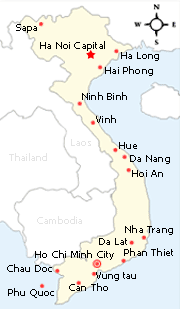|
The secret of Hoi An’s ancient wells Besides relics including ancient houses, temples and tombs, ancient wells are a special part of Hoi an ancient town, a world cultural heritage site.
Most old wells in Hoi An are located in the northern bank of the De Vong river, in Cam Thanh commune and Thanh Ha ward. These wells are often 50-150m from the river and some are even closer.
In Hoi An’s suburbs, ancient wells are mainly in circles but wells in Hoi An’s inner area are often square or in a circle at the top but square at the bottom. These wells are mainly located in temples and club-houses of Chinese Vietnamese.
According to Hoi An authorities, there are three major forms of ancient wells: circle (63 percent), square (17 percent), circle at the mouth and square at the bottom (15 percent) and other shapes. The most famous well in the town is Ba Le.
Ancient wells in Hoi An were built in different times. Some researchers believe the wells in circle at the mouth and in square at the bottom were built by Cham people before the 15th century and others were built by Vietnamese and Chinese after that.
Though they have different shapes, these wells all have iron and wood made frames, which are submerged in the water. This frame is used to prolong the lifespan of wells, preventing the well walls collapsing. The well walls are made by bricks which are arranged without mortar. Water runs through the slits between bricks to enter the well. In addition, all wells have altars worshipping the well gods.
Nguyen Chi Trung, director of the Centre for Preservation of Hoi An’s Relics, said that Hoi An’s people believe that each well has its own god who protects the well and ensures pure water.
Though ancient wells are located near a river their water is clear and cool all the year round. The water levels are always stable, even in the dry season.
All food specialties of Hoi An, such as cao lau and my quang and other cuisines are cooked with water taken from these wells.
VietNamNet/Dan Tri
Other news for Monday 14 December, 2009
View all news for Monday 14 December, 2009 on one page News for Wednesday 09 December, 2009
View all news for Wednesday 09 December, 2009 on one page Recent News
|










